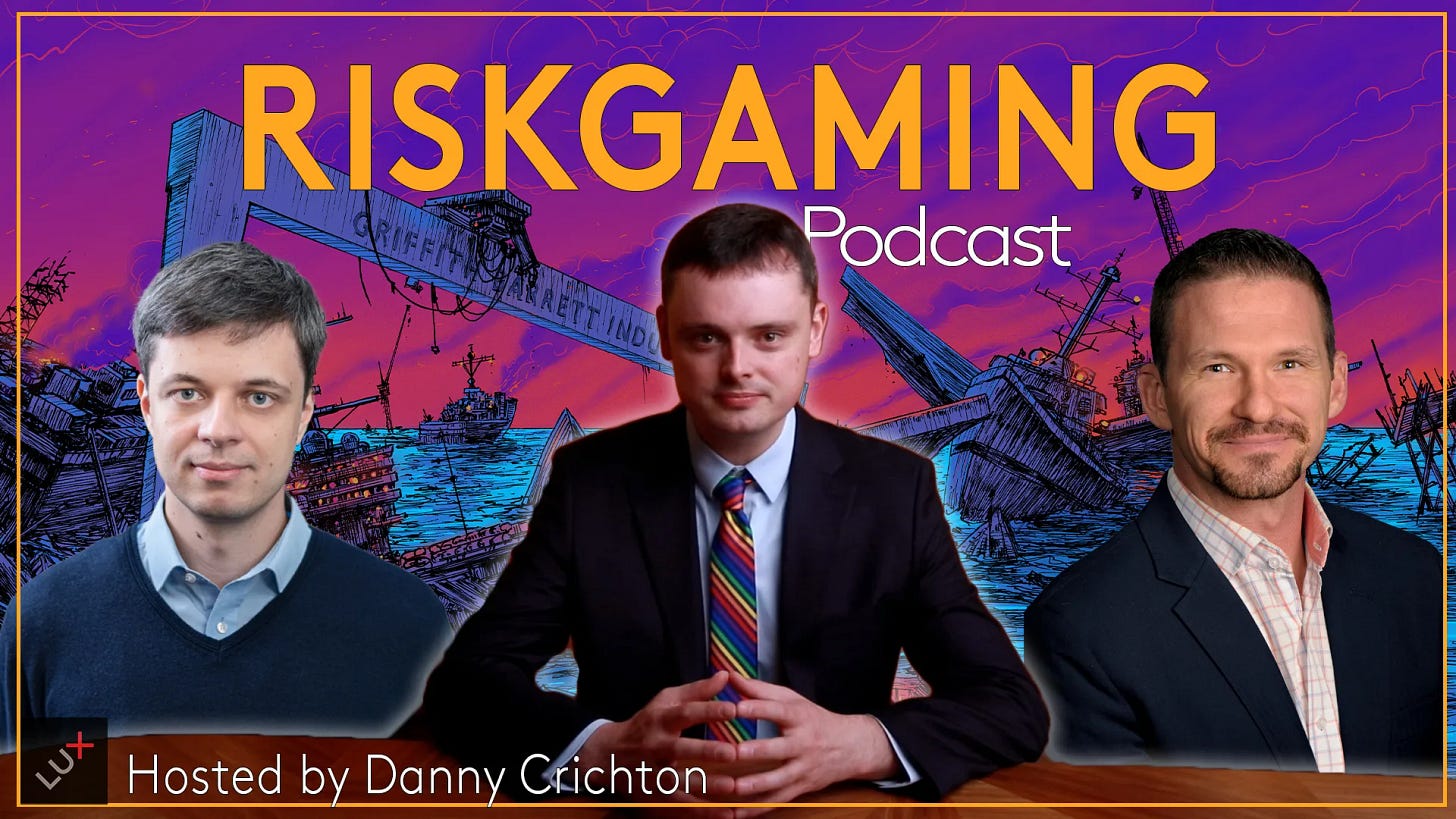The global future of wargaming in Lithuania
What games tell us about the future of war, politics and economics
Wargaming (of which Riskgaming is but one example) has a long and global history, from Europe and Asia into the Americas. Yet, its utility is increasingly being recognized by business, military and political leaders as a more authentic way to understand the behavior of people across all kinds of contexts. Competition, incentives, risk and decision-making flow together in a way that traditional policy memos and consultant-written PPTs can’t compare.
That’s part of the work that Pijus Krūminas is focused on. He’s a professor at Lithuania’s ISM University of Management and Economics and is the head of its Wargaming Lab. His research converges the social sciences into modeling and simulations, tapping into fields like political economy, game theory, management and more to create a new synthesis.
Subbing for me this week is Ian Curtiss, our independent Riskgaming scenario designer, who recently launched Southwest Silicon as Lux’s latest offering.
Ian and Pijus talk about simulating the polycrisis, how academic research flows into wargaming design, how students are learning through experiences, why political economy is overlooked compared to traditional military wargames, and a variety of recommended games for newcomers to the field.
This interview has been edited for length and clarity. For the full episode, please subscribe to our podcast.
Ian Curtiss:
How did you land on wargaming? I think you’re at a really interesting place, career wise, to be so heavily involved with the wargaming community while also working at a school of business and economics.
Pijus Krūminas:
Yeah, indeed, I’ve been teaching at a private business school since 2012, and I started more on the political science side. And one of the thoughts I had is how to make the seminar activities more interesting. At the same time, I was teaching comparative politics through models. So, it’s a little bit of mathematics, and so on. And sometimes those models don’t necessarily come alive. They make sense once you solve them, you see how they work, but internalizing them is challenging.
About the same time, I got Phil Saban’s book Simulating War, where he discusses how he used wargaming to simulate battles. And that gave me the idea that maybe I could turn some of those models we discussed in class into a game we could play. So I would present the model, and how it looked mathematically. And then in the seminar, these groups of students would play with some adjustment of the same model.
And then a couple of years later, I talked with the head of the undergraduate program in political economy and I said maybe we could form a course focused specifically on wargaming as a methodology. Basically the same thing we did in class, but in the course they would become creators of the interactive models. Since then, we’ve been having this class every year with new students coming in.
Last September, we launched a wargaming lab at the university, also kind of a project activity that would give us a little bit more room to explore the potential of wargaming, for example, for research.
Ian Curtiss:
From your student’s perspective, how do you encourage them to model political economy as a game? Because when we — meaning the gaming community — talk about these difficult-to-measure concepts, people get so jittery about gamifying them, putting hard metrics on these things.
Pijus Krūminas:
One thing I do is basically I give them freedom in terms of the topic as long as it broadly fits within the political economy. So, they can go into historical examples, or they can model something more present. And I think giving them freedom to select their theme also makes them a bit more open. Not everybody would necessarily like to work on a kinetic war game, because of the topic, but then an election, or something like that, they would. Or we had a game on privatization processes in the 1990s in Lithuania. After the Soviet Union collapsed, the state had a lot of stuff it didn’t need. So, privatization takes place, and how it turns out, and to who are the winners, the losers, et cetera.
So, there’s different types of topics, and I think students go with what they know they can work with, and what they want to work with.
Ian Curtiss:
This brings me to the original thing that drew me toward your work: your presentation at Connections UK a year ago. I remember you defined wargaming as the combination of game theory, agency theory and relationship theory. And I think that’s just a beautiful way to describe it.
Pijus Krūminas:
Thanks. So, my basic idea is that wargaming stands at the crossroads of different social science methodologies, divided into two large parts. One group is specifically focused on determining the relationship between different factors, agents or whomever. And that can be purely empirical models, such as regression models, econometric models or system dynamics models.
Wargaming is the combination of game theory, agency theory and relationship theory.
And the other part is where you talk about the model’s decision-making capacities. That’s less about defining the relationship, and the trend, and more making assumptions about the actual behavior — so behavior modeling such as game theory, where you would make assumptions about rationality, or agent-based models where you would give rules to individual agents and then run a computer simulation for thousands of times to find out whether you have emerging patterns.
Wargaming can benefit from those different areas of research — for example, about emerging macro patterns from agent-based modeling. If you need to set up specific incentives in a war game, for example, you can look at the mechanism design literature, and then you structure your policy based on that specific goal. And the other part is we need to know how these things actually work, and that’s where all of these relationship-focused models can contribute.
Wargaming can borrow from all of those. And at the same time, wargaming can give back to each of these different fields, in that if you have a game theoretic model, a war game can allow you to test the assumptions or behavior. You can see what actual behaviors people do.
Ian Curtiss:
This is the beauty I find in this whole methodology. But the frustration is that it’s really difficult to get hard data from games in a practical manner without putting them into a computer and just running them a thousand times. Like you said, nobody has the time to play a game a thousand times. So, how do you leverage the games to achieve learning outcomes with your students in the political economy sphere?
Pijus Krūminas:
I heard a comment some time ago at the end of the course when students said, “No, I hate board games, but these make sense.” So, I think the important part comes from demonstrating that a game can be more than just a fun way to spend time. It can still be a fun way to spend time, but at the same time it is teaching something. And this helps to connect the subject to the learning outcomes of the program in general, because it contributes directly to their modeling skills.
It also contributes to critical thinking, and it contributes to independent thinking and independent learning through the game’s decision-making process and then arguing why you made one or another decision. And in the end, when they have to provide their own projects, it’s not only the rule set that they have to provide, they also have to provide designer notes where they explain why they made a choice for the game mechanics.
Ian Curtiss:
The powerful part of game design is, as you said, the rules and the game notes. And so not only are you as a designer having to think about what you are modeling, you have to create an argument, and a thesis behind your argument. You’re also building strategic empathy, as I call it, for the decisions people have to make in these scenarios.
And that’s a totally different outcome, and a totally different service you provide to a player instead of a reader. I’m curious, do your students see it that way?
Pijus Krūminas:
One of the things we discuss, actually, from the very start is who you are representing in the game. When they start working on their own games, that’s one of the first questions they have to answer. So, who exactly are the players? Because knowing that question shows you what decision space you can have, what is outside of the player’s control, and what is under the player’s control. If you don’t answer that question — who are you as a player, or as the decision maker — you can’t have a game.
We had an interesting talk today at the university, and I think one thing that came through quite strongly was the expected impact games could have on society in terms of education, and making decision-making better, and also working with different sectors to help them make better decisions, either through participating in games, or giving them skills they need to learn the game. So, I think there’s also an identification of these activities with longer-term outcomes, outcomes that are outside of the university with broader spillovers in the society.
Ian Curtiss:
What are the biggest surprises you’ve seen from your own students and the games they’ve designed?
In general, we humans are limited by the models we are given.
Pijus Krūminas:
That’s a great question. One thing that stands out is the variety of topics. I don’t think we’ve ever had a repeat topic. So, certainly, you see the different interests come out of the designs, and other times it can be just integration of the games they know well, and transforming those mechanics into something else. For example, the game on privatization, they used some of the mechanics from Ticket to Ride.
From the games we play, what we see is that the ones we start with usually have the largest impact on students’ own designs. And so you play something, and then the mechanics carry over, et cetera. So, it’s interesting how these early games can have an impact on the final models in a student’s game.
Ian Curtiss:
That’s beautiful. What a great example. In general, we humans are limited by the models we are given.
So, I always talk about the games I make, and the research I do, mostly on gray zones — where the boundaries are moving in society. But “gray zones” are also talked about in war activities. My expertise is in China, but Russia of course does a lot of gray zone activities, and you’re in Lithuania very close to Ukraine.
I’m curious from a wargaming perspective, how is this all playing out for you in your field, and how do you see the field being applied there in Lithuania?
Pijus Krūminas:
That’s a very good question, and I think that’s the key benefit of wargaming, or riskgaming. It lets you sit at the crossroads with a lot of uncertainty and with a broad range of scenarios that could happen. I mean, if you have a kinetic war, it’s something you could reasonably analyze using other methods because you have a lot of data. The problem with the gray zone situations is that you don’t have the data.
And I think that’s where Riskgaming, or wargaming allows you to test out these different strategies in a safe and relatively cheap environment. For example, this spring, we had a “polycrisis simulation,” and we focused exactly on non-kinetic effects. We had an event that was… first it was tariff related. Then it was an increased presence of Russian and Belorussian troops along the Kaliningrad and Belarus border. It was not spilling over to a hot conflict, but it affected the investment climate. So, we didn’t go into this kinetic war phase, we just looked at what could happen otherwise that would affect the economy.
Coming back to the second part of your question on the regional awareness of wargaming, I think it’s increasing. I’m not necessarily talking specifically about Lithuania, but talking about around the Baltic Sea. The Polish are organizing their first wargaming conference in October, and want to get people from the region from Central Eastern Europe to come and join.
Ian Curtiss:
To wrap things up, two questions. What five or so games would you recommend for a wargaming class, and then what are your favorite economic, or political economy games?
Pijus Krūminas:
Okay, so the first question I can answer with what I always start with: The Shores of Tripoli by Kevin Bertram at Fort Circle Games, because it looks beautiful, and for a first engagement that’s very important. The game also structures the narrative well. It’s a topic that my students don’t — well, I’m not sure if anybody know much about it, including me before I got the game. It is about the Tripoli pirates, and Tripolitania, and how the United States got involved there. The narrative flows so easily through the game, and it’s really easy to engage students, plus it has a lot of dice rolls, which helps build excitement.
What I then like to play is John Company by Cole Wehrle, because it allows players to pose interesting questions. It’s sort of an economic game, and you are basically shareholders running a company, in this case the East India Company, but it also has all these questions hiding behind the players’ actions. So, what are you actually doing in India? Your actions can have very negative consequences. The game award system incentivizes you to prioritize your own personal gain over the company’s. And I think this leads to interesting questions that can then be discussed.
My students also always use Maria from Histogames. It’s a light war game, but it does well with the point-to-point movement, battle mechanics, and how you can use cards as a first introduction.
I also use The British Way, one of the COIN games from Stephen Rangazas, and I think it works very well because we play four scenarios. The model is very easy to see, what are the different relationships, and so on. And because we run different scenarios, we can then compare. So, if the core system is similar, you have some modifications, and they can help you tell a different story, whether it’s in Cyprus, or Malaya, or one of the other scenarios.
And this year we also played Churchill, which I think added a good diplomatic element to the games we explored because the war is very abstracted there. You advance toward Berlin, or you advance toward Japan. But a lot is going through the cards where you send guys to deal and negotiate over different issues.
When I have a larger group and can’t run a physical game, I like Take That Hill by Phil Sabin. I made a PowerPoint version of it, so I can easily move stuff and I ask players to vote using Slido. We run the game once or twice for them to internalize how it goes and then I show how it would look if you map out all of the relationships. So, basically map the model out, and it’s so confusing. Suddenly something you learned easily within one, or two turns, is confusing. So that is a good illustration.
And also this year with my students, I played Daniel Bullock’s The Gods Will Have Blood, it’s about the French Revolution, and it’s a solo game. So all the students acted as one and sort of voted for what decisions they would make. You are the judge or magistrate during the French Reign of Terror and during the French Revolution. And so you have to either condemn somebody or not, and we made it a bit ceremonial. It worked well to show how a game can also be emotional, and how it can tell a story of you as an individual can get pushed by the system.
Ian Curtiss:
There’s nothing like the French Revolution to educate people on how systems can push you towards terrible ends.
Pijus Krūminas:
Yeah.
Ian Curtiss:
Well, Pijus, this is fantastic. I so appreciate this, and love the conversation, and you dove so deeply into so many different aspects of this. Thank you so much for joining us.






